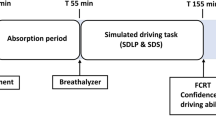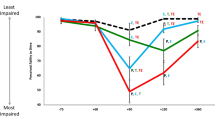Summary
Sixteen healthy male and female volunteers took part in a 6-way, double-blind cross-over trial to compare the effects of single doses of cetirizine 10 mg, loratadine 10 mg and placebo, with and without alcohol (0.72 g·kg−1, lean body mass). Performance was measured in two repetitions of a psychometric test battery, and a standard, over-the-road driving test. EEG was also measured during driving. Alcohol significantly affected almost every performance measure and altered the EEG energy spectrum during driving whilst the blood concentrations declined from 0.37 to 0.20 mg·ml−1. The effects of cetirizine of on driving performance resembled those of alcohol. It caused the subjects to operate with significantly greater variability in speed and lateral position (‘weaving’ motion). The effects of alcohol and cetirizine appeared to be additive. Certain cetirizine-placebo differences in subjective feelings and test battery performance were also significant. Loratadine had no significant effect on any performance parameter. It was concluded that cetirizine, but not loratadine, generally caused mild impairment of performance after a single 10 mg dose.
Similar content being viewed by others
References
Betts T, Kenwood C, Dalby G, Hull B, Wild J (1988) A comparison of the effects of two non-sedating antihistamines (terfenadine and cetirizine) on tests of CNS function (including driving). Paper presented at the joint annual meeting of the Canadian College of Neuropsychopharmacology and the British Association for Psychopharmacology. Cambridge, UK
Campoli-Richards DM, Buckley MM-T, Fitton A (1990) Cetirizine: a review of its pharmacological properties and clinical potential in allergic rhinitis, pollen-induced asthma, and chronic urticaria. Drugs 40: 762–781
Eriksen BA, Eriksen CW (1974) Effects of noise letters upon the identification of a target letter in a nonsearch task. Percept Psychophysics 16: 143–146
Froentjes W (1968) Factoren van invloed op de hoogte van het bloedalcoholgehalte. In: Buikhuisen (ed) Alcohol en verkeer. Boom, Meppel
Gengo FM, Gabos C, Mechtler L (1990) Quantitative effects of cetirizine and diphenhydramine in mental performance measured using an automobile driving simulator. Ann Allergy 64: 520–526
Godthelp J (1988) The limits of path error neglecting in straight lane driving. Ergonomics 31: 609–615
Hilbert J, Radwanski E, Weglein R, Luc van GP, Symchowicz S, Zampaglione N (1987) Pharmacokinetics and dose proportionality of loratadine. J Clin Pharmacol 27: 694–698
Jasper HH (1958) The ten twenty electrode system of the International Federation. Electroenceph Clin Neurophysiol 10: 371–376
Jex HR, McDonnell JD (1966) Critical tracking task for manual control research. IEEE Trabs Fac Electron HFE 7: 138–145
Louwerens JW, Gloerich ABM, Vries de G, Brookhuis KA, O'Hanlon JF (1987) The relationship between drivers' blood alcohol concentration (BAC) and actual driving performance during high speed travel. In: Noordzij PZ, Roszbach R (ed) Alcohol, drugs and traffic safety. Elsevier Science Publishers B. V. (Biomedical Division)
Monroe EW (1988) Chronic urticaria: Review of nonsedating H, antihistamines in treatment. J Am Acad Dermatology 19: 842–849
Moskowitz H (1973) Laboratory studies of the effects of alcohol on some variables related to driving. Safety Res 5: 185–199
Norusis MJ (1986) SPSS/PC + Advanced Statistics. McGraw-Hill, New York
O'Hanlon JF (1984) Driving performance under the influence of drugs, a rationale for, and application of, a new test. Br J Clin Pharmacol 18: 121–129
Riedel WJ, Ramaekers JG, Uiterwijk M, O'Hanlon JF (1990) Higher doses of terfenadine and loratadine; acute and subchronic effects on psychomotor and actual driving performance. Institute for Drugs, Safety and Behavior IGVG 90-08
Seidel WF, Cohen S, Bliwise NG, Dement WC (1987) Cetirizine effects on objective measures of daytime sleepiness and performance. Ann Allergy 59: 58–62
Spector SL, Altman R (1987) Cetirizine, a novel antihistamine. Am J Rhinology 1: 147–149
Sternberg S (1969) Memory scanning: mental processes revealed by reaction time experiments. Am Sci 57: 421–457
Author information
Authors and Affiliations
Rights and permissions
About this article
Cite this article
Ramaekers, J.G., Uiterwijk, M.M.C. & O'Hanlon, J.F. Effects of loratadine and cetirizine on actual driving and psychometric test performance, and EEG during driving. Eur J Clin Pharmacol 42, 363–369 (1992). https://doi.org/10.1007/BF00280119
Received:
Accepted:
Issue Date:
DOI: https://doi.org/10.1007/BF00280119




